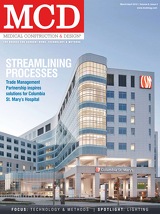Medical Construction & Design (MCD) is the industry's leading source for news and information and reaches all disciplines involved in the healthcare construction and design process. To view more past issues go to: http://mcdmag.epubxpress.com
Page 60 of 70
TECHNOLOGY & METHODS
Hand-held tablet computers are one component of improved medical care.
need to be summoned about what may be perceived as another layer of technology — and the mecha- nization and dehumanizing of the environment where a sick person has to be. The layout of the patient experi- ence will need to be redesigned to soften
the high-tech instrumentation. New technological concepts of integrating families into the care team could allow basic care responsibilities to be shared yet still be monitored
by clinical professionals. As the patient room evolves toward greater participation of families, the layout criteria will again be tested.
BEYOND EMR
home, thereby freeing up physical space at the facility? How will new technologies, real-time integration,
research or translational medicine impact the layout of a clinical practice? Could some patients typically cared for in the clin-
ical setting be managed electronically and remotely at home? What devices would be needed for data and voice transmissions and what power sources are required? With the future inclusion of robotics to automate
some tasks in support of reducing staff, how might patient room or procedure room needs change? How would automation impact the rate of speed
at which admission and discharge procedures occur and therefore room turnaround?
CHANGE, CHANGE, CHANGE
In addition to the physical and visual control of patient areas, staff stations are traditionally de- signed for easy access to paper medical fi les. As EMR replaces paper, storage space can change into computer space. The "tether" to the staff station being broken with hand-held devices leads to whole new models of care, such as bedside charting and service-line integration of inpatient and ambulatory patients. When the familiar clipboard medical charts are
replaced with wall-mounted, touch-control comput- ers, or hand-held tablet computers, new ideas will
56 Medical Construction & Design | March/April 2012
The advent of eMedicine will permit advances far beyond EMR, propelling medical care to new heights, such as: > Voice over Internet protocol telephone systems. > "Smart" medical equipment that communicates with doctors and nurses about patient condition.
> Texting capability between healthcare profes- sionals, labs, pharmacies, PT/OTs and outpatient clinics.
> Nurse call systems that handle admissions, discharge and transfer of data.
> Locator software for staff, patients and hospital resources.
> Patient bed interfaces such as voice and video communication.
> Remote surgery via robotics operating on the same network as EMR.
eMedicine is clearly part of the immediate future
of hospital operations and design. New costs and challenges will come with its inclusion, but opportuni- ties also will be created that drive healthcare to new levels of excellence. Infrastructure needs will increase to integrate this technology into the healing environ- ment. Healthcare designers and engineers, hospital administrators and staff all recognize there are great benefi ts that come with the creation of these new models of healthcare delivery.
Dennis Kaiser, AIA, LEED AP, is a principal of Perkins+Will. He can be reached in the Boston offi ce at 617-406-3433 or dennis.kaiser@perkinswill.com.
www.mcdmag.com
